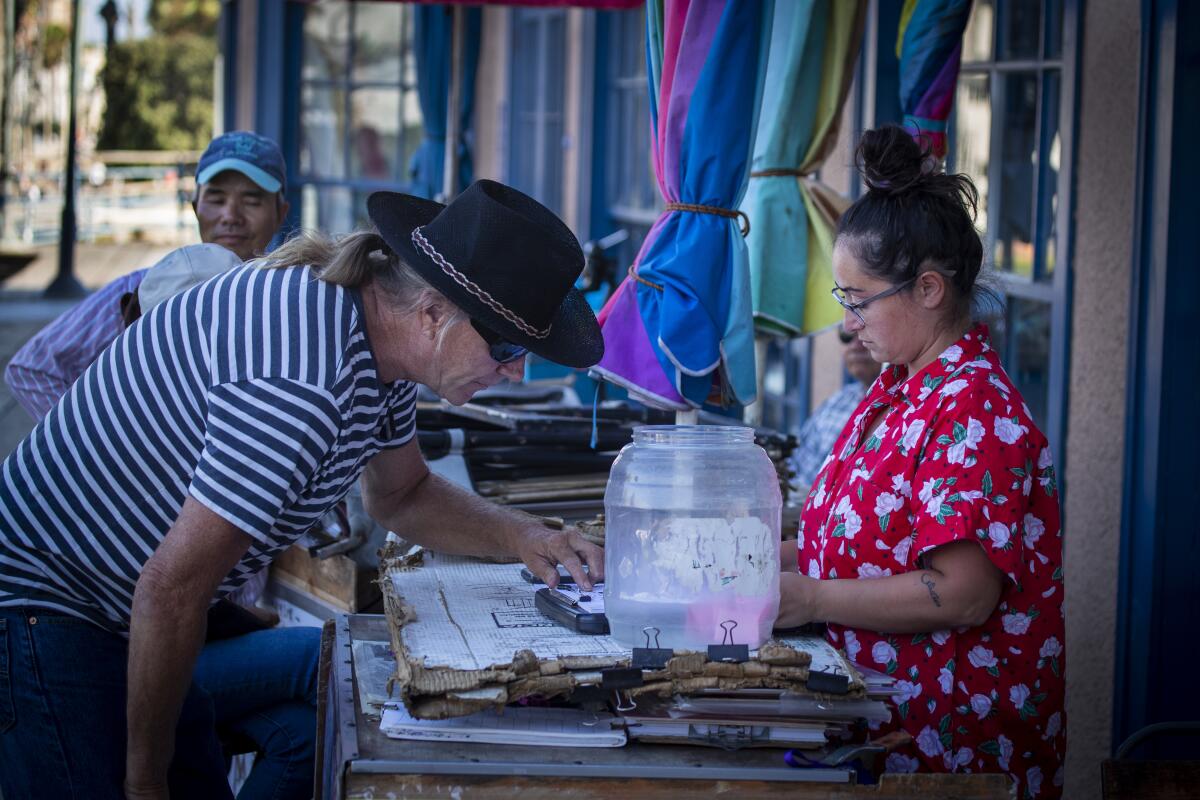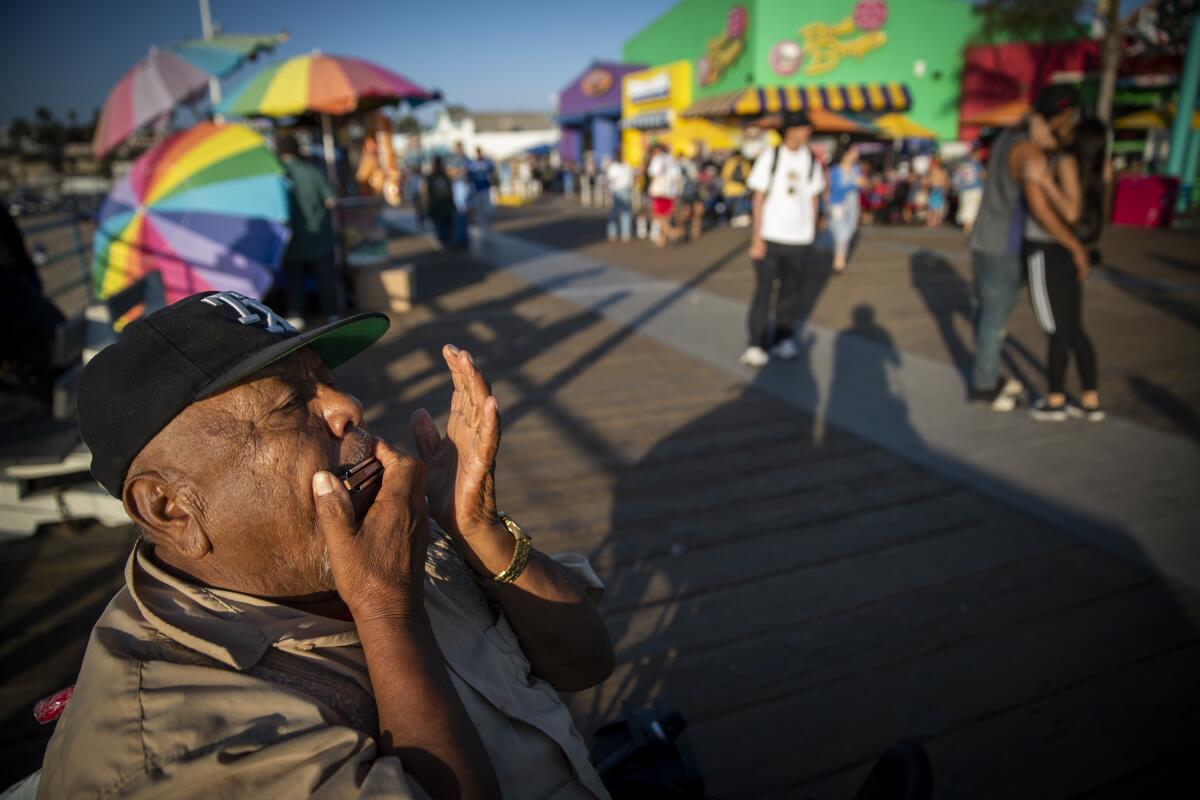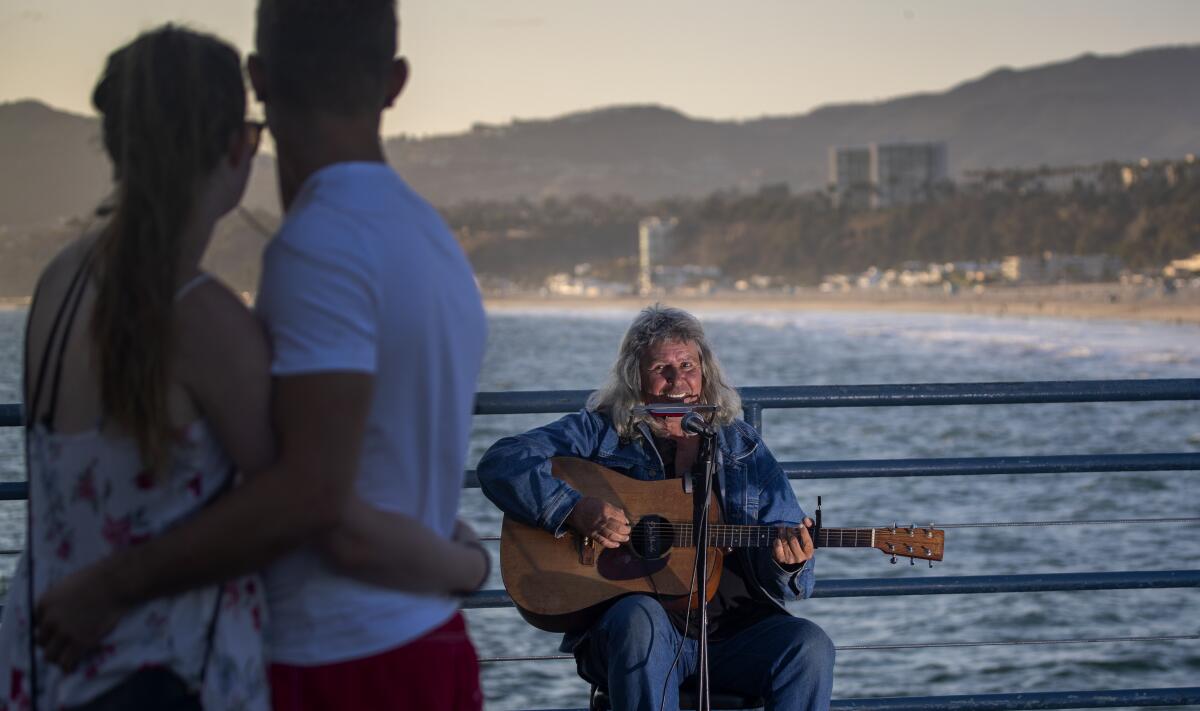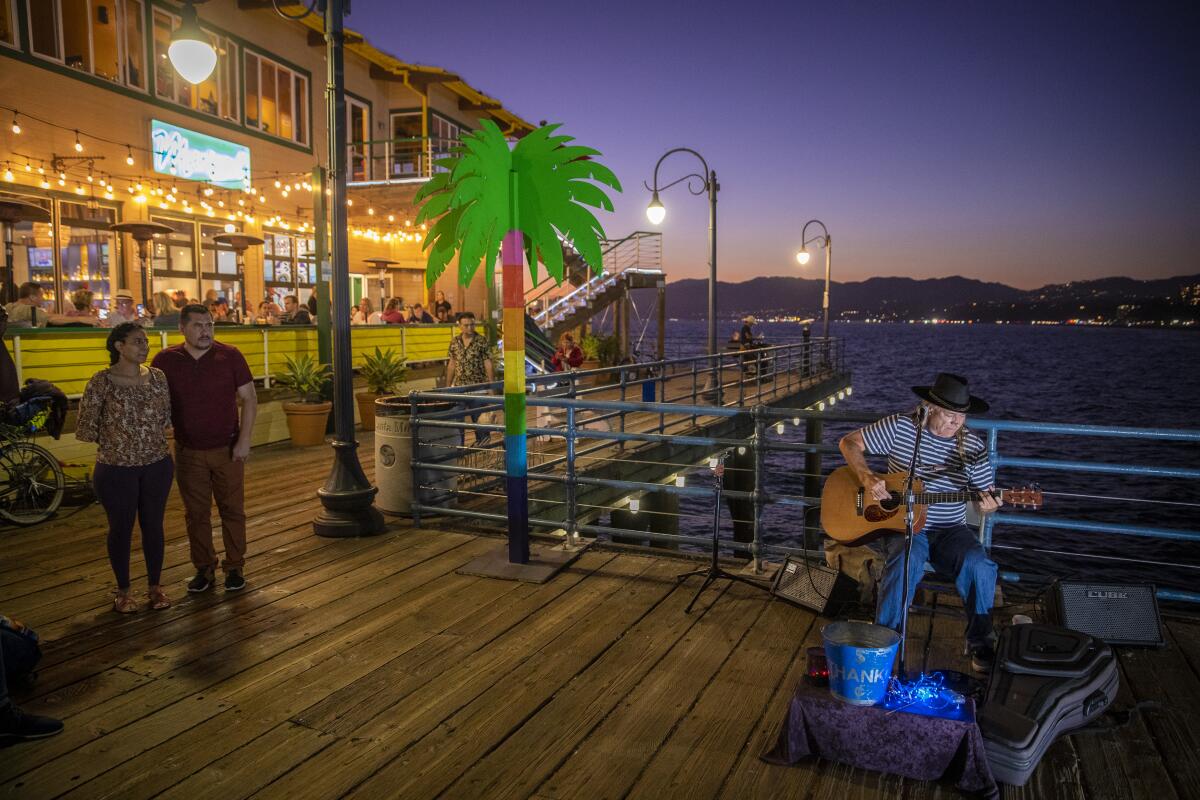At the Santa Monica Pier, performers hope a lottery wins them a lucky space

- Share via
Corey Hart sat in the shade of the Santa Monica Pier’s carousel building on a hot summer Friday, a clear 5-gallon plastic tub at his side.
The tub was filled with perhaps 50 blue slips of paper, each with a name. A crowd gathered, keeping a respectful distance as the lottery commenced.
Hart swirled the contents of the tub with a showy vigor, then thumped it back down on the weathered boards by his seat. He reached in, grabbed a slip and barked out a name.

A fresh-faced young man who went by the name “Kiev” pushed forward. A violinist, he was given the privilege of picking a prized spot — and the right to earn a buck — as a licensed street vendor in one of the nation’s busiest beachfront tourist meccas.
To be a street performer on the Santa Monica Pier, it helps to be lucky. There are only 24 designated spaces on the pier, and on a summer weekend there can be 50 or more performers at the 5 p.m. lottery drawing. Those whose names are not drawn may walk up the hill to Palisades Park or the Third Street Promenade and ply their self-expression there. But in Santa Monica, the Broadway lights shine brightest on the pier.
“I feel like here I’m part of the circus. You know, you got the amusement park. So people expect entertainment to be here,” said Terry Prince, a 42-year-old who performs love songs on the pier. “On the Promenade, it’s almost viewed as a nuisance by a lot of the merchants and the people there.”
Andrew Singer of Wisconsin said singing on the pier feels like a potential stepping stone to something better: “It’s kind of like a mailroom job in the music industry.”
For the performers and artists, the spaces along the pier vary greatly in desirability. That’s why the lottery is so important. The last slips handed out usually correspond to the least attractive choices. But the hierarchy of spots isn’t always so obvious.

For example, more people stream across the entrance of the pier, which draws almost 10 million visitors a year, said Jim Harris, deputy director of the nonprofit corporation that manages events there and the author of the pier’s official history: “Santa Monica Pier: A Century on the Last Great Pleasure Pier.” On a busy summer weekend, it would not be unusual for 50,000 people to pass space No. 1 — the pier’s entrance — in a day.
But that spot sits by the beach stairs and is sandwiched between Oatman Rock Shop and a group of street vendor carts, potentially overwhelming a performance — whether by a magician or a balloon artist. As a result, spots farther down the pier are often more desirable. Musicians must also consider how close they want to be to another musician or singer. Magicians, who want the audience’s rapt attention, might not want to share an area with break dancers using amplifiers to lay down a thumping beat for their moves.
Space No. 14 at the end of the pier probably sees less traffic than spaces closer to the entrance, but a performer there has the ocean as a backdrop and faces two sets of stairs that create a natural amphitheater.

Prince enjoys space No. 14.
He has been performing his love songs for 18 years — most of them on the pier. He came to Santa Monica from Las Vegas to see friends. When he saw the street performers here, he said, “You know what, I can do this.” He returned to Las Vegas, packed up “and never looked back.”
Performing on the pier has given him the opportunity to play all over Europe, he said. “Some people came here, they saw me and they said … we want to bring you to Germany, and they brought me to Germany, Austria, Switzerland. I went to Slovenia.”
Before the lottery, the situation was more eat or be eaten for the many fighting for so few spaces.
“People were becoming territorial,” Prince recalled. “People were sleeping in their cars so they could be first on the list, or they were having other people write their names on the list.”
Some of the participants say the system remains far from perfect. There is still wrangling over who should be considered a performer and not a vendor — the former qualify for a $37 permit, which is good for a year. And there are occasional accusations of selling spaces. But Prince said it’s a better situation than before.

The definition of “perform” is critical. Performing includes playing “musical instruments, singing, dancing, acting, pantomiming, puppeteering, juggling, reciting, engaging in magic, creating visual art … or similar artistic endeavors.” It does not include hair weaving or massage, or “the application of substances to others’ skin, including ... paints, dyes, and inks.”
For visual artists, the word “perform” includes making a drawing, sculpture or painting, but only if it is made on the spot “in its entirety.” The creation of handicrafts such as jewelry, pottery, leather goods or trinkets by “weaving, carving, stitching, sewing, lacing and beading” is not performance.
The city’s street performance ordinance walks the fine line between art and craft in order to distinguish performers from vendors. Vendors have no constitutional right to sell their wares in public places.
A street performer, however, is engaging in self-expression and under the 1st Amendment has the right to do so in public spaces like the pier. Santa Monica can make reasonable rules about the “time, place, and manner” of that expression but can’t forbid it.
Walt Davis was a grade-school teacher until he retired in 1985 and jumped into commercial art full time. Things were going well for him as a freelancer until he had the “misfortune of a client who had me do a lot of work and didn’t pay me.” To make ends meet while he sued, he began doing cartoon portraits for gratuities at Venice Beach. After a year, he said, he won his case but continued cartooning. He moved to the Santa Monica Pier in 1990 because of “all the craziness” in Venice.
Harris has been involved with street performers on the pier for more than 16 years. He thinks the lottery system is fair. But with the growth in visitors, he said, more performers have been attracted — and the limited number of performance spaces and times means there is competition and some inevitable tension, particularly in connection with the placement of musical performances and break dancing.
“The bottom line about the whole program here is that it is honoring the 1st Amendment,” Harris said. Because of that, Santa Monica doesn’t dictate “what kind of performer can be where,” how many of one kind of performer there may be, or even the quality of the performances. He thinks that is the right approach but regrets that “from the visitor’s perspective, there’s absolutely no understanding that we don’t have that kind of control.”
Kamen Chalakov was born in Bulgaria. He came to the United States at 33 and is now a citizen. He lives in Las Vegas, but for six months a year he comes to Santa Monica to draw caricatures on the pier.
At first, Chalakov did realistic portraits but now prefers caricatures because they are more entertaining. “I consider drawing caricatures a kind of therapy,” he said.
Chalakoc doesn’t understand why some of the performers complain about the lottery system. He thinks the system is fair. “All you have to do is just follow the rules and then nothing more than that,” he said.
The way he looks at it, the city is granting performers a privilege to entertain without charging a fee beyond the annual permit. No private company would do that. He is not sure some of the other performers appreciate that fact.
For Prince, playing the pier has been a gift. He plays “for thousands and thousands of people [from] all over the world who would never have heard of me.”
He said it can be lucrative but declined to be more specific, adding, “I tell people if it wasn’t working, people wouldn’t be coming back.”
He thinks the lottery system “works perfect because it is fair. Everyone’s name goes inside of a bucket and it’s randomly pulledout. I don’t know of any system that is more fair than that.”
He also thinks some performers are over-fixated on the spot they draw. “If you have a talent, people are going to stop and take note of that. … Every spot works for me.”
He smiles and repeats a line he has said many times before: “It’s not the spot; it’s what you got.”
More to Read
Sign up for Essential California
The most important California stories and recommendations in your inbox every morning.
You may occasionally receive promotional content from the Los Angeles Times.









